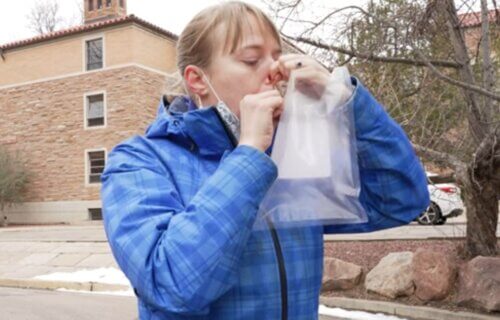BOULDER, Colo. — Can your breath reveal the presence of disease before it’s too late to act? Scientists from CU Boulder and the National Institute of Standards and Technology (NIST) have developed a groundbreaking laser-based breathalyzer, powered by artificial intelligence (AI), that has the potential to revolutionize medical diagnostics. Initially designed to detect COVID-19, the breathalyzer’s potential applications are far-reaching and could include detecting a range of diseases such as cancer and diabetes, highlighting the breathalyzer’s remarkable potential in the diagnosis of diverse conditions.
The breathalyzer is based on a technique called frequency comb spectroscopy. This technique uses laser light to distinguish one molecule from another, potentially identifying biomarkers of disease in human breath. The device has been improved significantly, with a thousand-fold increase in sensitivity, enabling it to detect trace molecules at the parts-per-trillion level. The team has also integrated AI into the system, which allows machine learning to analyze the data, recognize patterns, and develop criteria to make a diagnosis.
While the breathalyzer’s success in diagnosing COVID-19 is impressive, its true potential lies in its ability to diagnose a wide variety of diseases. For example, diseases like cancer and diabetes alter the body’s metabolism and cause unique changes in the composition of the breath. This implies that the breathalyzer, with its ability to detect trace molecules, could potentially diagnose these diseases by identifying their unique “breathprints.” This would be an enormous leap forward in medical diagnostics, offering a non-invasive, quick, and cost-effective diagnostic tool that doesn’t require the use of costly chemicals or uncomfortable procedures.
Efforts are already underway to miniaturize the breathalyzer system to a chip scale, allowing for real-time self-health monitoring. This could make medical diagnostics accessible and convenient for the average person, allowing individuals to check their health status on the go, potentially even using a device integrated into their smartphone. Early detection is crucial in managing diseases like cancer and diabetes, and this technology could be instrumental in this regard.
“What if you could find a signature in breath that could detect pancreatic cancer before you were even symptomatic. That would be the home run,” says molecular biologist Leslie Leinwand, chief scientific officer for BioFrontiers and a co-author on the study, in a university release.

The breathalyzer team also hopes to contribute to the development of a Human Breath Atlas, an initiative that aims to map each molecule in the human exhale and correlate them with health outcomes. This would involve a larger-scale collection of breath samples, providing a wealth of data that could aid in the understanding and diagnosis of a wide range of diseases.
Collaborations are also being formed with pediatric and respiratory specialists at the CU Anschutz Medical Campus. The aim here is to explore how the breathalyzer can not only diagnose diseases but also help scientists understand them better. This could offer insights into immune responses, nutritional deficiencies, and other factors that contribute to or exacerbate illnesses.
However, as with any new technology, challenges remain. Understanding the correlation between different molecules and specific health conditions is complex. Moreover, further research and refinements are necessary to improve the breathalyzer’s accuracy and disease-detection capabilities. Despite these challenges, the research team remains optimistic. They are dedicated to refining the breathalyzer, with the aim of making it even more sensitive and accurate, much like training a dog’s nose to detect a wide range of smells.
“There is a real, foreseeable future in which you could go to the doctor and have your breath measured along with your height and weight…Or you could blow into a mouthpiece integrated into your phone and get information about your health in real-time. The potential is endless,” says Jun Ye, a JILA fellow and adjoint professor of physics.
You might also be interested in:
- Covid breathalyzer test? Scientists move closer to breakthrough device
- New urine test can detect cancer early with just a piece of paper
- Diabetes breakthrough: Blood biomarker predicts disease onset 19 years before diagnosis
In conclusion, the breathalyzer developed by CU Boulder and NIST holds enormous potential in the field of medical diagnostics. Its ability to diagnose diseases such as cancer and diabetes through the simple analysis of breath, a non-invasive and rapid method, could revolutionize healthcare. By offering real-time, self-monitoring of health, it could make disease detection more accessible and convenient than ever before. While the technology is still in its infancy, the possibilities it presents are vast and transformative. The breathalyzer’s capacity to detect diseases at an early stage could significantly impact the outcomes for patients, allowing for earlier interventions, better management of the disease, and ultimately, improved survival rates.
Furthermore, this technology could potentially democratize healthcare, making diagnostics accessible to a broader population. In regions where access to healthcare services is limited, such a device could provide an invaluable means of early disease detection. Given its non-invasive nature and ease of use, the breathalyzer could be implemented in a variety of settings, from clinics and hospitals to homes and remote locations.
The device is described in the Journal of Breath Research.

